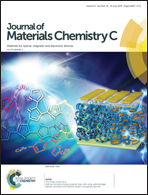High efficiency (∼100 lm W−1) hybrid WOLEDs by simply introducing ultrathin non-doped phosphorescent emitters in a blue exciplex host†
Abstract
Hybrid white organic light-emitting diodes (WOLEDs) have attracted increasing attention due to the combined advantages of long lifetime of blue fluorophor and high efficiency of red-green or orange phosphors. However, this often requires complex device structures, and its efficiency is far from meeting the desired requirements. Herein, a simple but efficacious structure is demonstrated to achieve extremely high efficiency hybrid WOLEDs, whose crucial feature is the exploitation of an exciplex as the blue emitter combined with an orange phosphorescent ultrathin layer (UTL). The resulting WOLEDs exhibit a low turn-on voltage of 2.35 V due to the smart energy level alignment and barrier-free carrier injection. The maximum forward viewing external quantum efficiency and power efficiency reach 22.45% and 97.1 lm W−1, respectively, and as high as 20.10% and 69.0 lm W−1, respectively, at 100 cd m−2, and 16.05% and 39.8 lm W−1, respectively, at 1000 cd m−2. Importantly, the location of UTL in the blue emitting layer has negligible effect on the driving voltage and efficiency. Such remarkable performance will promote the progress of high efficiency and low-cost hybrid WOLEDs.



 Please wait while we load your content...
Please wait while we load your content...